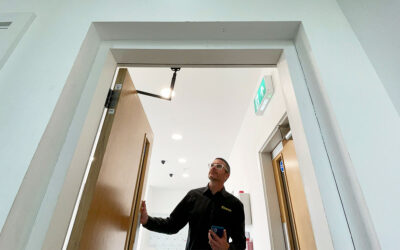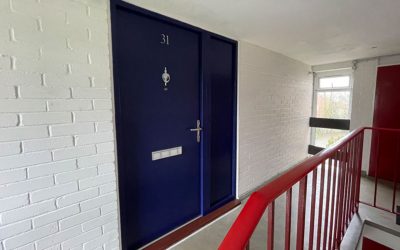Fire safety education isn’t just about what to do when the fire alarm sounds. It’s also about the prevention of fire, and methods to minimise harm and damage if a fire does break out. Prevention is the best form of firefighting. Training can stop fires from happening.
Employers are legally required to provide information, instruction and training to employees about fire precautions in the workplace. What are the four steps that need to be covered?
- Basic fire prevention
- Good housekeeping
- Risk awareness
- Smoking policy
Basic fire prevention
It’s important to improve fire safety culture to prevent fire in the workplace. Educate your staff about what is a fire hazard, and make sure they know who to speak to if they spot something they think could be dangerous.
Ian Gough, fire safety consultant and former firefighter, believes education is key when it comes to fire safety. “If people know why they shouldn’t do something, such as block evacuation routes or wedge open fire doors, they’re more likely to stop doing it. If they’re just told not to with no explanation, the chances are they’ll carry on doing it without thinking.
“People know they mustn’t wedge fire doors but do they really understand why? The average person doesn’t see it as important. They think it’s just a short-term measure, but then forget to remove the wedge.
“It’s important that people know why closed doors are so valuable. I’ve even seen non-fire-resistant doors hold back fire. A fire door only has to be open a crack for it to be useless and for fire and smoke to spread.”
Fire spreads quickly. Evacuation routes need to be kept clear so people can leave the building immediately. Fire doors are specially designed to hold back fire for a certain amount of time, so people can exit safely and the emergency services can tackle the fire. If fire doors are wedged open they can’t do their job, and fire and smoke will continue to spread rapidly.
Risk awareness
All businesses need a fire risk assessment which must be regularly checked and updated. Staff can help with this if they know what to look for. Has anything changed in the building that might cause a fire hazard? Has something blocked a fire exit? Has an important member of staff left? Is more training required?
Ian Gough said: “It’s important that the person that completes the fire risk assessment is familiar with the day-to-day running of the building. People need to be taught to look after their building and its individual needs.
“This is why it is so important for risk assessments to be ongoing; if something is spotted it needs to be noted down in the risk assessment. During a fire drill, if someone noticed that an evacuation route was difficult to use, for example, the plan would need to change.”
Housekeeping
A neat and tidy building creates a more pleasant environment and is also an important part of any fire safety strategy.
- Keep anything that can catch fire away from anything that can cause fire, such as a stove or a heater.
- Tumble dryers are a common cause of fire. If your building has one, ensure that the lint tray is cleaned daily.
- Never overload an extension cord or outlet. If a cord has any frayed wiring, it needs to be replaced.
- Keep clutter away from fire exits and firefighting equipment. If something is blocking an exit route it must be removed immediately. Also ensure electrical control panels are accessible.
- Discard fire hazards in a covered metal container and ensure the bins are emptied regularly.
- All machines should be regularly checked. Any electrical hazards should be reported and all repairs only undertaken by a professional.
- Prevent arson by ensuring the building is locked and windows are closed. Report anything suspicious.
Smoking policy
Any smoking areas should be well away from the building and there must be a place to dispose of cigarettes safely. Smoking is not permitted in the workplace (apart from certain exemptions such as smoking rooms in hotels or care homes).
Don’t forget your emergency plan
With all these precautions taken, the risk of fire is minimised but it is still a possibility. If the worst does happen, you’ll need an emergency plan.
We explore this more in-depth in a separate blog, but your emergency plan must cover:
- What to do if you discover a fire
- Alerting everyone if there’s a fire
- Evacuation procedure
- Emergency exits
- Contacting emergency services
- Firefighting equipment
If you’ve taken all the precautions recommended the risk to people and property is vastly reduced even if a fire does break out. Be sensible and be safe. If you see something that seems like it could be a fire risk: stop, think and act.
You might also like
Why it’s time to digitalise your fire door inspections
With the amount of information and recommendations that a detailed inspection report generates, going digital with your fire door inspections will help you stay compliant and in control of all fire doors within your premises.
3 ways to keep your fire doors open (that aren’t a door wedge!)
It’s common knowledge in fire safety circles that wedging doors open is wrong. So you might ask, “Why is this blog about ways to keep fire doors open?” Well, this is about options to do so safely and legally. But first, let’s look at why it’s hazardous to keep fire...
Q&A: The Lowdown on Fire Doors
With new developments happening thick and fast, we caught up with our Senior Commercial Manager, Alex Babbage, to get the lowdown on recent fire door projects at Fireco. This includes info about our tailor-made inspection software, DorTrak, which will provide you with a live view of your inspection as it’s happening.





Trackbacks/Pingbacks